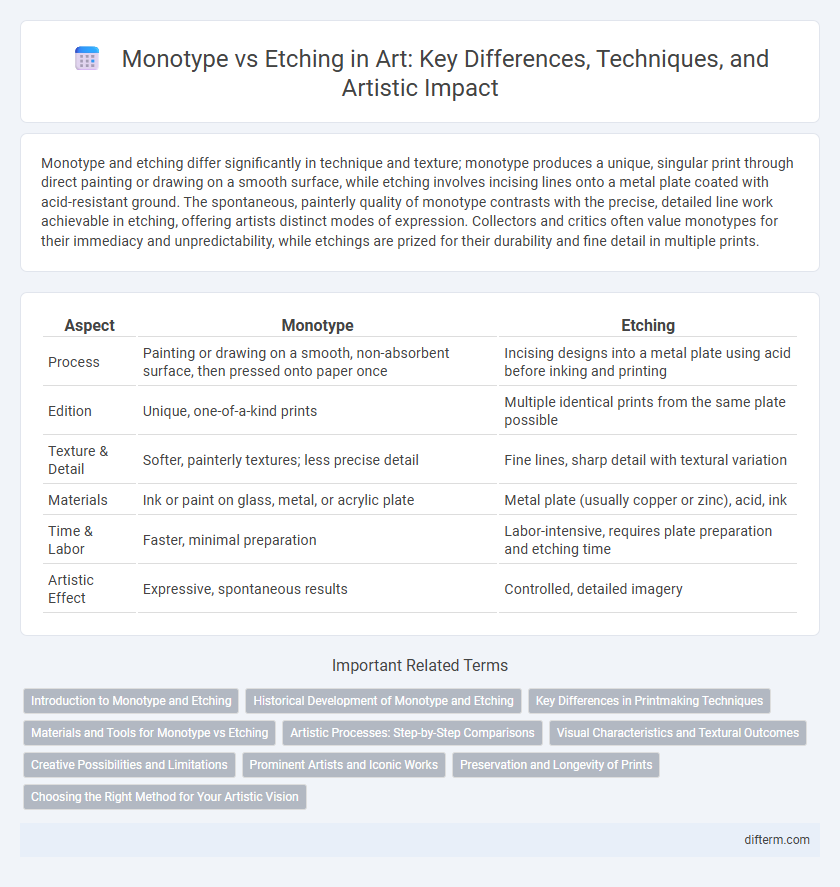Monotype and etching differ significantly in technique and texture; monotype produces a unique, singular print through direct painting or drawing on a smooth surface, while etching involves incising lines onto a metal plate coated with acid-resistant ground. The spontaneous, painterly quality of monotype contrasts with the precise, detailed line work achievable in etching, offering artists distinct modes of expression. Collectors and critics often value monotypes for their immediacy and unpredictability, while etchings are prized for their durability and fine detail in multiple prints.
Table of Comparison
| Aspect | Monotype | Etching |
|---|---|---|
| Process | Painting or drawing on a smooth, non-absorbent surface, then pressed onto paper once | Incising designs into a metal plate using acid before inking and printing |
| Edition | Unique, one-of-a-kind prints | Multiple identical prints from the same plate possible |
| Texture & Detail | Softer, painterly textures; less precise detail | Fine lines, sharp detail with textural variation |
| Materials | Ink or paint on glass, metal, or acrylic plate | Metal plate (usually copper or zinc), acid, ink |
| Time & Labor | Faster, minimal preparation | Labor-intensive, requires plate preparation and etching time |
| Artistic Effect | Expressive, spontaneous results | Controlled, detailed imagery |
Introduction to Monotype and Etching
Monotype and etching are distinct printmaking techniques that offer unique artistic expressions. Monotype involves creating a single, unique print by painting or drawing on a smooth surface, which is then transferred to paper, emphasizing spontaneity and fluidity. Etching uses acid to carve designs into a metal plate, allowing for precise, detailed lines and multiple reproductions from the same plate.
Historical Development of Monotype and Etching
Monotype originated in the early 17th century, popularized by artists like Giovanni Benedetto Castiglione, who used this printmaking technique to create unique, painterly impressions. Etching's historical development dates back to the 16th century, pioneered by Albrecht Durer and later refined by Rembrandt, who elevated it through intricate line work and tonal depth. Both techniques evolved alongside advances in metalworking and chemistry, influencing the production and artistic possibilities of prints throughout the Renaissance and Baroque periods.
Key Differences in Printmaking Techniques
Monotype prints create unique, one-of-a-kind images by painting or drawing directly onto a smooth surface, which is then pressed onto paper, resulting in a single impression without a permanent plate. Etching involves incising designs into a metal plate using acid, allowing artists to produce multiple consistent prints from the same etched plate. The main difference lies in monotype's spontaneity and singularity versus etching's capacity for detailed, repeatable editions.
Materials and Tools for Monotype vs Etching
Monotype printing primarily uses a smooth, non-porous plate such as glass or metal, along with oil-based or water-based inks applied with brushes, rollers, or rags to create unique, one-off images. Etching requires a metal plate, typically copper or zinc, coated with an acid-resistant ground, and involves tools like etching needles to draw through the ground, followed by acid baths to bite into the exposed metal. Both processes utilize printing presses, but monotype emphasizes direct manipulation of ink on the plate, whereas etching relies on chemical processes to create detailed, reproducible lines.
Artistic Processes: Step-by-Step Comparisons
Monotype involves creating a single unique print by painting or drawing on a smooth surface, which is then transferred to paper by pressing, resulting in a one-of-a-kind artwork. Etching requires coating a metal plate with a resistant ground, drawing into the ground to expose the metal, and then immersing the plate in acid to etch the exposed lines before inking and printing multiple copies. The monotype process emphasizes spontaneity and texture variation, while etching focuses on precision and line detail through chemical engraving.
Visual Characteristics and Textural Outcomes
Monotype prints feature unique, rich textures with smooth, painterly strokes and variable ink density that create soft transitions and spontaneous effects. Etching provides precise, linear details and sharp contrasts through incised metal plates, resulting in intricate textures and defined edges. The visual outcome of monotype emphasizes fluidity and unpredictability, while etching offers controlled, repeatable patterns with fine line work.
Creative Possibilities and Limitations
Monotype offers unique creative possibilities through its singular, one-of-a-kind prints, allowing artists to experiment with spontaneous textures and painterly effects that cannot be exactly replicated. Etching provides more precise detail and the ability to produce multiple consistent impressions from a single plate, making it ideal for intricate line work and repetitive editions. However, monotype's limitation lies in its impermanence and inability to create duplicates, while etching is constrained by its technical complexity and longer production process.
Prominent Artists and Iconic Works
Monotype, favored by Edgar Degas and Mary Cassatt, offers unique, singular prints exemplified by Degas's "Blue Dancers," showcasing fluid, painterly effects. Etching, mastered by Rembrandt and Francisco Goya, produces detailed, repeatable images, with Rembrandt's "The Three Crosses" and Goya's "Los Caprichos" standing as iconic works defining the medium's expressive depth. Both techniques remain pivotal in printmaking, highlighting contrasts between spontaneous monotype textures and the meticulous line work of etching.
Preservation and Longevity of Prints
Monotype prints possess unique, one-of-a-kind images but generally have less durability compared to etchings, which benefit from the use of acid-resistant metal plates that ensure finer, more detailed lines. Etchings exhibit superior preservation qualities due to their ability to withstand multiple print runs without significant degradation, making them ideal for collectors seeking long-lasting artworks. The longevity of etchings is enhanced by archival-quality inks and papers, while monotypes, being singular and made on less durable surfaces, require meticulous care to prevent fading and wear over time.
Choosing the Right Method for Your Artistic Vision
Monotype offers a unique, one-of-a-kind print with spontaneous textures and fluid lines, ideal for artists seeking expressive, painterly effects. Etching provides precision through detailed incised lines on metal plates, perfect for intricate designs and reproducibility. Selecting between monotype and etching depends on whether your artistic vision prioritizes singular, dynamic imagery or controlled, repeatable fine detail.
monotype vs etching Infographic

 difterm.com
difterm.com